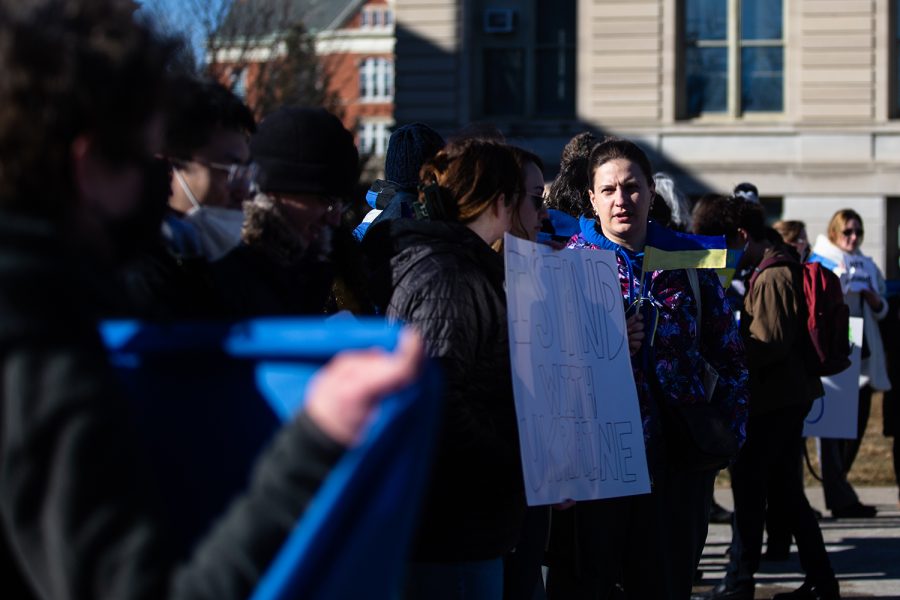Opinion | The Russia and Ukraine conflict explained
A brief recap of the history and events that took place that led us to the current day Russia and Ukraine conflict
Demonstrators line up during a pro-Ukraine demonstration at the Pentacrest at the University of Iowa in Iowa City. Around 80 people attended the demonstration.
February 28, 2022
Between classes, homework, clubs, and everything else students have on their plate, it gets hard to stay up to date with current news. With all the breaking news about war between Russia and Ukraine, many people may be confused on what exactly is happening.
This article will take you step-by-step through a brief history of the major events that have led up to where we are at in the current day.
Before we can even begin to understand the complicated dynamics between Russia and Ukraine in the present, we must take a deep dive into the past.
Starting in 1922, Russia and Ukraine were both part of the Soviet Union. When the Soviet Union fell in 1991, Ukraine gained its independence, as did many other countries that were under the USSR’s domain.
Being neighbors, Russia and Ukraine kept close ties post-Soviet Union because their people shared similar histories.
While they have kept a close relationship, the dynamics between Russia and Ukraine have been constantly shifting throughout changes in regimes and ideology.
In 2010, then-President of Ukraine Viktor Yanukovych was adamantly pro-Russia and did everything in his power to strengthen Ukraine’s ties with Russia at the expense of its relationship with the European Union.
In December 2013, Yanukovych refused to sign an agreement that would bring Ukraine into closer trade relation ties with the European Union, instead favoring a closer relationship with Russia.
This gave Russian President Vladimir Putin a greater sense of ownership over Ukraine, which added to the fire already brewing. Ukrainians saw this as their president selling them to Russia, and protests broke out on the streets.
Protesters eventually overthrew Yanukovych’s government, and Yanukovych was then exiled from the country and fled for safety to Russia.
In 2014, after Yanukovych’s ouster, Russian troops moved into Ukraine’s Crimean Peninsula. In a referendum, 97 percent of Crimean voters chose to join Russia, though this referendum was considered illegitimate by the United Nations.
Russian President Putin officially announced the annexation of the peninsula in March 2014. Fighting in the Donbas region of eastern Ukraine has continued since 2014, with Russian-backed separatists fighting Ukrainian forces in a conflict that claimed more than 14,000 lives.
In 2019, current Ukrainian President Volodymyr Zelenskyy was elected, and promised to return the Donbas region to Ukranian control.
Tensions continued to escalate through 2021 and the beginning of 2022, with Putin seeking to stop Ukraine’s ambitions to eventually join NATO.
This event helps paint the picture of the rising tension within Ukraine itself about maintaining these strong Russian ties.
For decades, there has been some division among Ukrainians about their sentiments toward Russia. Generally, western Ukraine feels completely separate from its neighbors, while eastern Ukraine has a more brotherly view of Russia. In the east there is a higher proportion of native Russian speakers, while more people in the west identify Ukrainian as their first language.
With a history of Russia imposing on Ukraine, it is not hard to see why eastern Ukraine might feel close to Russia. On top of Russia being its neighbor, one of every three Ukrainians speaks Russian as their native language, and one out of every six Ukrainians ethnically identifies as Russian.
All these factors contribute to Putin’s sense of ownership over Ukraine and make some groups in Russia support Putin’s cause.
There are many historical factors that contribute to this, with the most prominent being that Ukraine was heavily Russified by force throughout its history. For periods of time, the Ukrainian language was banned and parts of the Russian population were brought to live on Ukrainian soil.
With all of this in mind, the question is, what was the final straw?
It may take years before we know the exact reason, or perhaps we will never know. The significant fact is war is happening, and it is happening now.
The overarching theme of all these examples is that Russia has time and has repeatedly imposed itself on Ukraine. Because of this, Russia feels that it has the right to interfere with Ukraine sovereignty, at the expense of the Ukrainian people.
Present day, the conflict mainly revolves around Russia trying to take Ukraine territory by any means necessary, with little regard to Ukrainian casualties. This leads to the question, are we looking at the next world war, or a repeat of the Cold War?
Either way, history is being written before our eyes and if you haven’t been paying attention, now’s the time to start.
Columns reflect the opinions of the authors and are not necessarily those of the Editorial Board, The Daily Iowan, or other organizations in which the author may be involved.



